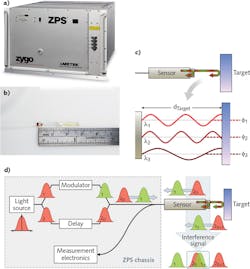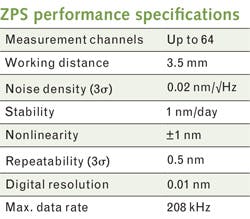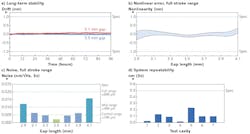ERNESTO ABRUÑA
Measuring to the nanometer scale is no small feat—getting there takes careful engineering and a fundamentally good sensor. The sensors used for stage position feedback inside semiconductor lithography tools regularly achieve this level of precision. Zygo has supplied displacement measuring interferometers (DMIs) to satisfy this application for 30 years.
Zygo has recently introduced the ZPS, an optical sensor system that delivers absolute position with subnanometer precision. Many sensors in the market claim to have this capacity—without an industry-standard definition, though, it is difficult to compare two different sensors and know what performance to expect. This article shares our experience, clarifies the common terms that describe the quality of a position sensor, and shows how ZPS delivers good performance.1
The ZPS system is a fiber-based optical sensor system that provides absolute position with low noise (≤0.02 nm/√Hz) and high repeatability (0.5 nm 3σ) over a 1.2 mm travel range. The system supports up to 64 synchronized channels with user-selectable data rates up to 208 kHz. It has utility in applications that require a high quality of measurement, a large number (>16) of measurement channels, or both.
Optical sensors provide several advantages over other technologies like capacitance gauges or encoders. Optical sensors are capable of direct measurements, insensitive to electromagnetic interference, and generate no heat. Cabling restrictions are minimal, as fiber cables can be quite long and are more flexible than electrical cables. ZPS sensors are very compact (3 × 27 mm on average) and enable metrology in applications with severe space constraints.
How ZPS works
ZPS combines three kinds of interferometry in a single device: multiwavelength, heterodyne, and coupled-cavity interferometry (see Fig. 1).
Multiwavelength interferometry is the technique of reconstructing absolute distance between two surfaces by solving multiple instances of the equation:
2d = mλ + φ
where d is the distance between the sensor reference surface and the target, λ is wavelength, and φ is the fractional (residual) interference term. The process for solving these equations is called the Method of Exact Fractions and was developed by Jean-René Benoît in 1898.
Multiwavelength interferometry enables ZPS to measure the actual distance between the sensor and the target. ZPS performs this technique by using three known wavelengths, measuring the residual interference terms and then solving for m and d. ZPS's algorithms result in a ≤0.5 nm 3σ repeatability. The process is done on all channels simultaneously in a one-second calibration step-heterodyne displacement interferometry is then used to track changes in d thereafter.
Heterodyne interferometry uses two frequencies of light to generate a constant signal because of temporal interference. This concept is analogous to FM radio, which modulates a carrier frequency to transmit information, resulting in a lower noise floor and better performance. This is why music sounds better on FM radio—the same improvement holds true for position interferometry. ZPS uses an electro-optic modulator to generate the carrier frequency.Coupled-cavity interferometers are used in conjunction with low-coherence light sources to measure displacement over short distances. A reference cavity establishes the nominal zero point of the measurement arm of the interferometer. ZPS employs this architecture by introducing a delay between the modulated and unmodulated light. This path delay sets the nominal standoff between the sensor and the target. A thermally stabilized cavity inside the system tracks for variations in the path delay and compensates the data in real time.
The table shows key performance specifications for ZPS—some of these terms are commonly published by all sensor manufacturers. The resolution is naturally taken to be the indicator of a performance and the metric by which different options are compared. However, with no standard in place, this number means different things when said by different companies. As always, the devil is in the details and it is important to read the fine print to understand what any of these specifications are saying about the performance of the sensor.
Resolution: what does it really mean?
Resolution may be the most misunderstood term used to describe a sensor's performance. In some cases, it is just the smallest counting increment from the device—the noise floor may be orders of magnitude higher. In other cases, it includes noise, but either fails to specify the bandwidth or hides it in very fine print. Low bandwidths and rolling averages trade dynamic response for improved resolution. It is always prudent to ask the supplier the bandwidth at which the resolution is specified.
Zygo uses the term digital resolution to indicate the smallest counting increment available. It is important that this number be below the noise floor (but not too far) to resolve the noise-limited performance of the sensor. With ZPS, we specify the digital resolution (0.01 nm), a bandwidth-independent noise (0.02 nm/√Hz), and the maximum bandwidth (104 kHz). These specifications can all be achieved simultaneously.
In addition to resolution, some companies are less than direct with other sources of error in their sensors. Zygo understands the total measurement uncertainty of our products and shares this with our customers.
Uncertainty: the real performance metric
The total uncertainty of a sensor system is the truest measure of its performance. Understanding uncertainty can be a graduate-level college course unto itself. The essential aim is to combine all the possible error sources statistically to generate a standard deviation. ISO's Guide to the Expression of Uncertainty in Measurement (also known as the GUM) provides a thorough overview of the process.2 In addition to noise, major sources of uncertainty for position sensors include environmental effects, nonlinearity, stability of length scale, and mounting.
Bob Hocken, former director of the Center for Nanoprecision Metrology and Distinguished Professor at the University of North Carolina Charlotte, once quipped, "Every machine I ever made was also a thermometer." It is no surprise that temperature changes affect sensor behavior. Noncontact sensors must also consider pressure, humidity, and gas content when operating outside of a vacuum. ZPS has a refractometer accessory that detects the actual refractive index of the air, and automatically compensates sensor measurement values against environmental effects in real time to subnanometer levels.
Each sensor technology has its own sources of nonlinearity. For interferometers, this typically comes from spurious reflections and manifests itself as a sinusoidal error in the data, earning it the name cyclic error. For other sensor technologies, nonlinearity may come from the limits of the factory calibration. It is important to know that these terms exist and how big they are. ZPS deals with nonlinearity by factory calibration for low-order terms and through a patented active compensation process for cyclic error. The result is a very low residual nonlinearity of ±1 nm.
The stability of a sensor's length scale is a fundamental consideration for achieving low uncertainty. The length scale for interferometer systems is the wavelength of light used in the measurement. ZPS actively monitors changes in wavelength using thermally controlled cavities housed within the chassis. The system continuously applies compensation for wavelength changes to the measured data automatically. ZPS's specification is ≤1 nm/day, although qualification data shows actual stability to be significantly better.
Sensor mounting is a consideration often overlooked by designers new to the challenges of precision metrology. Motion of the sensor mount is indistinguishable from motion of the target, regardless of the technology used. It is crucial to identify the sensor's reference surface and keep it fixed over the anticipated thermal and vibration ranges. ZPS's reference surface is on the front face of the sensor, allowing for the design of a tight metrology loop. Other sensors have ill-defined reference surfaces or bury them within the sensor package, adding uncertainty and making it more difficult to produce good metrology.ZPS performance
Despite all the challenges, nanometer-level metrology is possible. The graphs in Fig. 2 show example data of actual ZPS performance. Descriptions of the test conditions are provided below.
Stability. Zygo evaluates stability by measuring air-spaced Zerodur cavities in a standard lab environment (±0.5°C), with environmental compensation applied via refractometer accessory. To isolate the stability measurement from noise, each data point represents an average over one second. The result is <0.2 nm drift over a four-day period.
Nonlinearity. ZPS data is taken simultaneously against a helium neon laser-based DMI system. The graph shows the bounds of the cyclic error superimposed on the low-order effects. Low-order nonlinearity comes from the phase change as the target travels through the beam focus. The result is a ≤±0.4 nm nonlinearity over the full measurement range.
Noise. Zygo uses solid-glass etalons to eliminate mechanical vibrations. The measurements were taken in a nominal lab environment at 5 kHz and then converted into a bandwidth-independent noise figure. ZPS has a tiered specification where the central ±100 μm range has a fourfold improvement in noise compared to the full range.
Repeatability. Air-spaced Zerodur etalons are used to eliminate mechanical noise. The calibration routine that establishes absolute distance is run repeatedly over the course of several hours. The result is shown to be well below the 0.5 nm 3σ specification for seven different test etalons.
With a clear understanding of uncertainty, it is easier to compare sensors, even when they employ disparate fundamental technologies. Zygo's precision metrology experience enables production of position sensors like ZPS to meet the uncertainty needs of a wide range of applications.
REFERENCES
1. See U.S. patents 7,636,166; 7,639,367; 7,826,064; and 9,115,975.
2. See www.bipm.org/en/publications/guides.
Ernesto Abruña is the product manager for precision position sensors at Zygo Corporation, Middlefield, CT; e-mail: [email protected]; www.zygo.com/zps.


